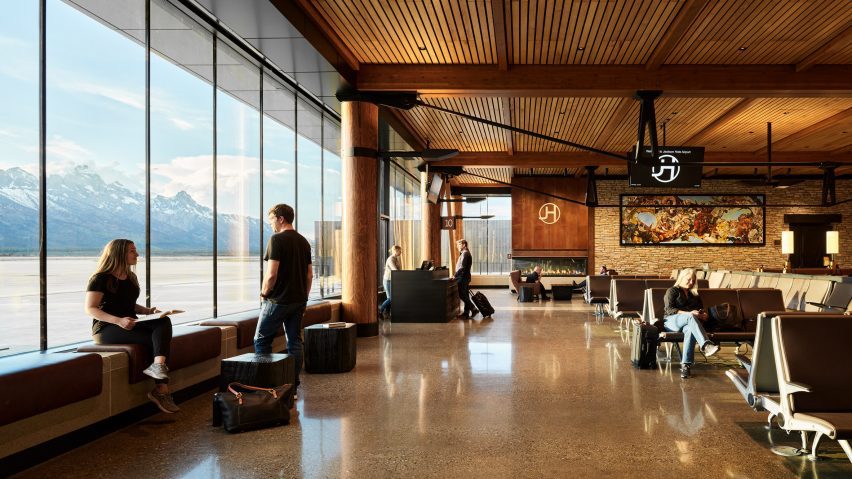Fireplaces, warm lighting and large windows offering views of the Teton Range are among the features at the renovated and expanded Jackson Hole Airport in Wyoming, which is the only commercial airport within an American national park.
Located in the mountainous Grand Teton National Park in the western part of the state, the airport dates to the 1930s and has undergone various changes over the decades.
Around 2009, it received a major update by the Denver office of global studio Gensler, with Jackson-based CLB Architects serving as the local associate architect.
In more recent years, CLB has served as the design architect for a series of renovations and additions spanning five phases. Miller Dunwiddie, a Minneapolis firm, served as executive architect.
The project was designed to tie into the landscape and "facilitate the flow of 21st-century travelers", while also adhering to strict area and height limits imposed by the national park.
The facility is the only commercial airport located within a US national park, according to the federal agency that oversees the parks.
The work included a new restaurant/bar, an expanded holding area, two additional gates, a gift shop and an updated baggage claim area with retail space — all held within the L-shaped terminal totalling 125,000 square feet (11,613 square metres).
"Design decisions facilitate an easy and stress-free travel experience, with open floor plans and clear sight corridors, as well as abundant glazing that frames the airplane runways and Teton Mountain range beyond," said CLB Architects.
Interior finishes are a mix of earthy and industrial materials, including polished concrete, quartzite and timber – all meant to stand up to heavy use, as 800,000 travelers pass through the airport each year.
For the structural system, the team paired lightweight steel with Douglas fir glue-laminated beams and rough-hewn log columns. The structural supports are meant to have "an elegant and minimal presence".
In addition to the natural light that flows in through large windows, the terminal has downlights, uplights and LED accents that create a feeling of warmth.
"Indirect up-lighting creates an evocative, atmospheric quality that contrasts with the usual cold, fluorescent lighting of institutional airport spaces," the team said.
Throughout the facility, the team blended elements of residential design into the travel hub.
"It was our intent to make the experience feel more like a residential space rather than a commercial one," the team said.
On the northern side of the terminal, where passengers wait to board their planes, the studio created a "living room" with comfy furniture, commissioned artwork and a monumental fireplace.
Glazed walls are lined with polished concrete benches with leather seat cushioning, where visitors can watch aircraft take off and land. The waiting area also features a grab-and-go concessions counter and a casual restaurant with a fireplace.
The terminal is designed to be highly flexible, so rooms can be reconfigured as needed. To that point, the airpot has an underground area of approximately 3,000 square feet (279 square metres) that was envisioned as a "versatile flex space".
CLB had two additional projects underway at the airport – a private terminal and three hangar structures.
Other US airport projects include the ZGF-designed expansion to the Portland International Airport, which features a massive timber roof, and plans for a highly sculptural air-traffic-control tower in Columbus, Indiana, designed by Marlon Blackwell Architects.
The photography is by Matthew Millman.
Project credits:
Design architect and architect of record for phases 3-7: CLB Architects
CLB team: Kevin Burke (partner), Cary Lakeman (senior project manager), Steve Jakub (project manager)
Executive architect for phases 3-7: Miller Dunwiddie
Interior design: TruexCullins (restaurant and hold room)
Contractor: Wadman Corporation
Civil consultant: Jviation
Geotechnical engineer and well design: Nelson Engineering
Structural engineer: KL&A
Mechanical, electrical, plumbing, technology engineer: Michaud, Cooley, Erickson
Lighting: Helius Lighting Design
Food service: The Marshall Associates
Life, safety, accessibility: Jensen Hughes
Acoustic engineer: Wave Engineering
Client: Jackson Hole Airport
Owner's representative: KLJ Engineering

